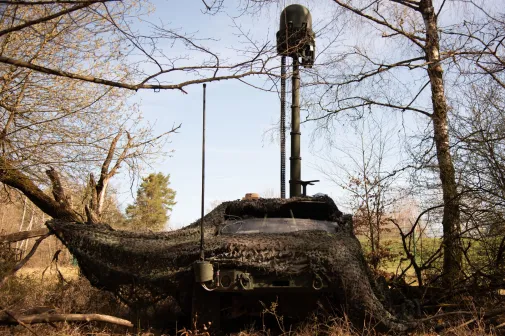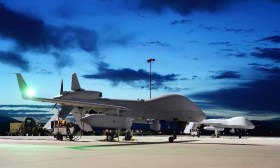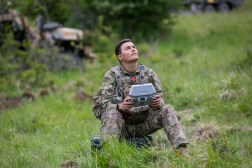Army embarking on electronic warfare data pilot to help inform rapid reprogramming

The Army will be beginning an electronic warfare data pilot to determine what it needs to be able to rapidly reprogram systems on the battlefield.
Part of the effort stems from lessons learned during Russia’s invasion of Ukraine.
“We’re learning that the EW landscape is changing everywhere between three weeks and three months, and so that we need to be more flexible in our approach … The battlefield is changing really, really rapidly,” Gen. Randy George, chief of staff of the Army, said during testimony before the Senate Armed Services Committee in April.
As a result, the force must become more agile.
“This forces the Army to design for agility — EW payloads (techniques and software) must be dynamic and reprogrammable so they can be delivered from a variety of independent platforms” like drones, tactical vehicles and manpacks, among others, David May, a senior advisor at the Cyber Center of Excellence, said in response to questions from DefenseScoop. “Consequently, the Army is shifting its EW paradigm, moving away from inflexible, tightly coupled solutions and towards a more adaptive and responsive approach. This involves developing and integrating new technologies within an Army Reprogramming Enterprise.”
The Army has not fielded any program-of-record electronic warfare systems used for jamming or defense since the war on terror, delivering only quick-reaction capabilities to forces in response to threats they’ve encountered in their regions.
Over the last several months, George has discussed an emerging concept dubbed transforming in contact, in which the Army plans to use deployments and troop rotations to test new equipment — mainly commercial off-the-shelf gear — to allow units to be more responsive on a dynamic battlefield.
Within the concept, there are three areas where George says the Army needs to be faster and more adaptable when it comes to delivering equipment to forces, due to how dynamic the threat environment is and the cat-and-mouse aspect of countering moves: unmanned aerial systems, counter-UAS and electronic warfare.
May stated that the reprogrmaming enterprise changes software within the EW payloads — described as electronic warfare sensing and effects delivery — that can be customized based on the size, weight and power limitations of the platform.
That payload is then employed according to a scheme of maneuver, May said, adding that in order to maintain advantage, changes must be made in a timely manner — less than 48 hours.
What has been less clear in recent months is the extent to which the Army will have reprogrammers at the tactical edge to make these adjustments in near real-time.
“EW requirements should be synchronously coordinated with this paradigm shift (Platforms to Modular Mission Payloads), ensuring that they align with the proposed changes and prioritized appropriately within the Reprogramming Enterprise,” May said.
George has maintained that the Army will not be going back to foreign service representatives or contractors that accompany soldiers to war zones that maintain equipment.
“I want to not have FSRs. For everybody out here, I mean, we want to develop easy-to-use things that can be repaired or you take a tablet or something that can be exchanged, because we’re not going to have these big [forward operating bases] like we’ve had in the past and doing these things,” George said at a conference in March. “We have very technically savvy troops that can do a lot of these things.”
That leaves soldiers to performing the reprogramming. The Army’s 17D designation are coders and developers both in the cyber and electronic realms.
In 2021, the service embarked on a pilot effort dubbed Starblazor, to place coders and software developers at the tactical edge to reprogram electronic warfare and radio frequency systems.
The Army has continued to recognize the need to have coders at the edge.
“Everything from a concept of platform and payload disaggregation, let’s design a platform and then let’s apply payloads to it from an electronic warfare perspective. Starblazor was key in helping us develop those insights,” Maj. Gen. Paul Stanton, commander of the Cyber Center of Excellence, told reporters during a conference in October. “Understanding the right physics problem also was a major outcome from Starblazor — at what range and what distance, within what frequency band do we want to be able to operate. It also helped us understand the agility needed in the development and potential manipulation of our payloads. We recognize that the enemy has signals of interest. We also recognize that the enemy signals of interest will change. We’ll see new things on the battlefield that we did not anticipate and we have to be prepared for.”
Stanton recognized that the Army must have tactical engineers capable of tweaking a payload in accordance with a modification or a previously unseen event in the electromagnetic spectrum.
May said the results from Starblazor are providing the starting point for a new pilot.
Army Cyber Command and CCoE “are embarking on an EW Data Pilot that serves as a campaign of learning for a conceptual Army Reprogramming Enterprise,” May said. “The Pilot will focus on enhancing the understanding and implementing EW data needs supporting the rapid reprogramming of modular mission payloads. This learning is necessary to enable the future approach to EW effects on the battlefield supporting the operational force’s scheme of maneuver.”
The ultimate goal of the pilot effort is to develop capabilities using advanced EW concepts throughout the next year of learning based on a series of events from division and theater exercises, May said.
While the focus of the pilot is on the data and defining requirements for a data platform, architecture and standards, the effort will also help the service align polices and procedures, refine organizational structure and outline a governance strategy to enable a reprogramming enterprise, May added.
“Ultimately the pilot will help inform how the Army can augment its current capability and capacity to execute effects in the EMS at the speed and scale necessary to provide the Army and joint force an edge in Large Scale Combat Operations,” he said.






